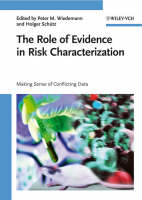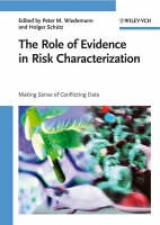The Role of Evidence in Risk Characterization
Wiley-VCH (Verlag)
978-3-527-32048-6 (ISBN)
- Titel ist leider vergriffen;
keine Neuauflage - Artikel merken
One of the few books to focus on the critical problem of the correct characterization of conflicting data for an adequate risk evaluation, this title comprehensively covers the different approaches in various research areas in the US and in Europe, while also considering the ethical implications of risk evaluation. In addition, special attention is paid to the sensitive topic of potential health risks through electromagnetic fields.Written by leading experts in the field, this is an indispensable resource for policy makers and professionals in health risk assessment.
Dr. Wiedemann is the Director of the Programme Group MUT at the Research Centre Jülich. He has extensive work-experience in the field of societal conflicts over modern technologies with a focus on risk communication and evidence characterization. A field of special interest is the potential risk of electromagnetic fields. Dr. Wiedemann was elected President (in 2002 and 2003) of the Society for Risk Analysis - Europe (SRA-E). He was called to serve in different sub-committees of the German Radiation Protection Commission and served as a member of the EMF Communication Group at the WHO EMF Project (1998-2000). Holger Schütz is a senior scientist at the Programme Group MUT. His research focus is on risk perception and risk communication, comparative assessment of environmental health risks, and evidence assessment. He is the first author of the book "Comparative Risk Assessment" published by Wiley-VCH in 2006.
Making Sense of Conflicting DataThe Role of Evidence in Risk CharacterizationEditors: Peter M. Wiedemann&Holger SchützPreface (Vecchia, 5 - 8 pages)1. Introduction: The Role of Evidence in Risk Characterization (Wiedemann&Schütz)2. From Scientific Analysis to Risk Policy (each 8 -10 pages)2.1. Risk Characterization and Precautionary Measures (Deventer)2.2. Risk Characterization and Policy Making (Vogel&Delfini)3. Making Sense of Conflicting Data: Evidence Characterization in Different Research Areas (each 8 -10 pages)3.1. Clinical Studies (Eikmann&Herr)3.2. Epidemiology (Schüz)3.3. Evidence Based Medicine (Katalinic)3.4. Animal Studies (Lerchl)3.5. Genotoxicology (Obe)4. Making Sense of Conflicting Data: Procedures for Characterizing Evidence (each 8 -10 pages)4.1. IARC (Cogliano)4.2. California EMF (Neutra)4.3. Swiss Approach (Röösli)4.4. Strahlenschutzkommission (SSK) (Leitgeb)4.5. MUT Approach (Evidence Maps) (Schütz&Wiedemann)5. Psychological and Ethical Aspects in Dealing with Conflicting Data (each 8 -10 pages)5.1. Traps in Causality Judgements (Thüring)5.2. Intuitive Risk Perception and Uncertainty (Schütz, Thalmann&Wiedemann)5.3. Ethical Views on Dealing with Uncertainties (Tannert&Potthast)6. Practical Implications (8 -10 pages)6.1. How to Manage Unclear Risks: A Evidence Based Framework6.1.1. Science Issues6.1.2. Perception Issues6.1.3. Policy IssuesPages without references: 150 - 180 pages
| Erscheint lt. Verlag | 28.5.2008 |
|---|---|
| Sprache | englisch |
| Maße | 170 x 240 mm |
| Gewicht | 580 g |
| Einbandart | gebunden |
| Themenwelt | Naturwissenschaften ► Biologie ► Mikrobiologie / Immunologie |
| Schlagworte | Gesundheitsrisiko • Gesundheitswesen • Public Health • Risikobewertung • Risikomanagement |
| ISBN-10 | 3-527-32048-2 / 3527320482 |
| ISBN-13 | 978-3-527-32048-6 / 9783527320486 |
| Zustand | Neuware |
| Haben Sie eine Frage zum Produkt? |
aus dem Bereich




